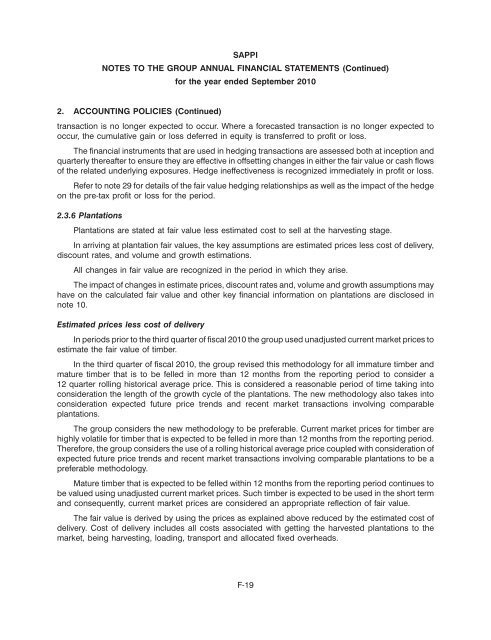You also want an ePaper? Increase the reach of your titles
YUMPU automatically turns print PDFs into web optimized ePapers that Google loves.
<strong>SAPPI</strong><br />
NOTES TO THE GROUP ANNUAL FINANCIAL STATEMENTS (Continued)<br />
for the year ended September 2010<br />
2. ACCOUNTING POLICIES (Continued)<br />
transaction is no longer expected to occur. Where a forecasted transaction is no longer expected to<br />
occur, the cumulative gain or loss deferred in equity is transferred to profit or loss.<br />
The financial instruments that are used in hedging transactions are assessed both at inception and<br />
quarterly thereafter to ensure they are effective in offsetting changes in either the fair value or cash flows<br />
of the related underlying exposures. Hedge ineffectiveness is recognized immediately in profit or loss.<br />
Refer to note 29 for details of the fair value hedging relationships as well as the impact of the hedge<br />
on the pre-tax profit or loss for the period.<br />
2.3.6 Plantations<br />
Plantations are stated at fair value less estimated cost to sell at the harvesting stage.<br />
In arriving at plantation fair values, the key assumptions are estimated prices less cost of delivery,<br />
discount rates, and volume and growth estimations.<br />
All changes in fair value are recognized in the period in which they arise.<br />
The impact of changes in estimate prices, discount rates and, volume and growth assumptions may<br />
have on the calculated fair value and other key financial information on plantations are disclosed in<br />
note 10.<br />
Estimated prices less cost of delivery<br />
In periods prior to the third quarter of fiscal 2010 the group used unadjusted current market prices to<br />
estimate the fair value of timber.<br />
In the third quarter of fiscal 2010, the group revised this methodology for all immature timber and<br />
mature timber that is to be felled in more than 12 months from the reporting period to consider a<br />
12 quarter rolling historical average price. This is considered a reasonable period of time taking into<br />
consideration the length of the growth cycle of the plantations. The new methodology also takes into<br />
consideration expected future price trends and recent market transactions involving comparable<br />
plantations.<br />
The group considers the new methodology to be preferable. Current market prices for timber are<br />
highly volatile for timber that is expected to be felled in more than 12 months from the reporting period.<br />
Therefore, the group considers the use of a rolling historical average price coupled with consideration of<br />
expected future price trends and recent market transactions involving comparable plantations to be a<br />
preferable methodology.<br />
Mature timber that is expected to be felled within 12 months from the reporting period continues to<br />
be valued using unadjusted current market prices. Such timber is expected to be used in the short term<br />
and consequently, current market prices are considered an appropriate reflection of fair value.<br />
The fair value is derived by using the prices as explained above reduced by the estimated cost of<br />
delivery. Cost of delivery includes all costs associated with getting the harvested plantations to the<br />
market, being harvesting, loading, transport and allocated fixed overheads.<br />
F-19
















